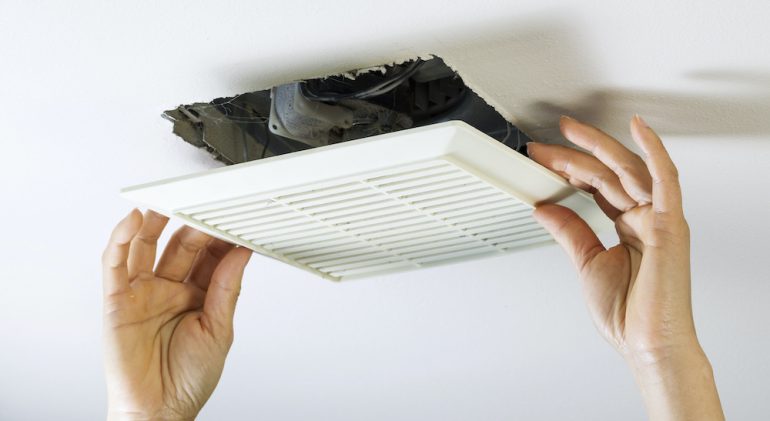The bathroom exhaust fan gets little attention, but it serves an important role in maintaining air quality in your bathroom and home. If your bathroom doesn’t have a fan, consider installing one, and set up a regular cleaning schedule to maintain your fan. Here’s what you need to know.
Moisture and odor elimination
The purpose of bathroom exhaust fans is to vent moisture and odors to the exterior of your house. Without a fan, steam fogs your mirrors and, more importantly, leads to moisture damage and the growth of mold in your bathroom. You should run the fan during every bath or shower and for several minutes afterwards.
Opening a window simply isn’t as beneficial as using a bathroom exhaust fan. A fan suctions moist air out of the bath, but a window may actually make things muggier if the outdoor air is humid. And in the depth of summer and winter, you sacrifice your indoor temperature comfort level when you open a window. Chances are you won’t, which means the moisture will remain in the bathroom.
Building codes and inspections
Municipal building codes across the country are inconsistent as to whether homes must have bathroom exhaust fans, but most newly constructed homes have them. The fans weren’t built into older homes. If you’re selling your home, you can be sure the buyer’s inspector will take note if your bathrooms don’t have fans, whether or not code requires them.
Installing a bathroom exhaust fan
To retrofit a five-foot-by-eight-foot bathroom with a fan costs on average about $350 to $400, although a DIY installation of a simple fan can run less than $100, and installation of a premium model with multiple upgrades can cost $500-$800. Installing a new bathroom exhaust fan will probably require new wiring or reconfiguration of old wiring.
Be sure to choose the right size fan for your bathroom. If the fan is too small, it won’t be effective. If it’s too large, it will be noisy and use more energy than necessary. Bathroom exhaust fan power is measured in cubic feet per minute (CFM). The larger your bathroom, the higher the CFM your fan should have. A standard bathroom requires a fan with a CFM of 70 to 90.
When installing a bathroom exhaust fan, be sure it is vented to the outdoors through your roof or a gable, not into your attic. Venting the fan into the attic will eventually cause mold to grow there, which is tough and expensive to eliminate.
Cleaning your bathroom fan
Bathroom exhaust fans accumulate dirt with day after day of regular use. Dirty fans don’t work as efficiently, so you should clean your fan every six months.
First, turn off power to the device at the circuit breaker. Remove the cover, and clean it by washing it in warm soapy water or by placing it on a towel and vacuuming it with your brush attachment. Clean inside the housing and around the motor with the vacuum’s dusting tool. You can also wipe out grime inside the fan with a damp microfiber cloth. Let everything dry thoroughly before reassembling.
Related – Small Space, Big Style: Bathroom


